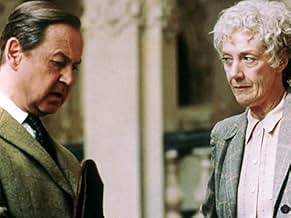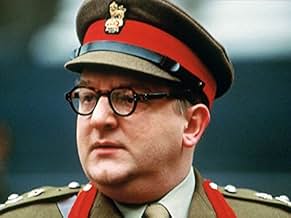IMDb-BEWERTUNG
7,5/10
565
IHRE BEWERTUNG
Füge eine Handlung in deiner Sprache hinzuAnthony Powell's twelve volume novel sequence "A Dance to the Music of Time" has been dramatized for television.Anthony Powell's twelve volume novel sequence "A Dance to the Music of Time" has been dramatized for television.Anthony Powell's twelve volume novel sequence "A Dance to the Music of Time" has been dramatized for television.
- 1 BAFTA Award gewonnen
- 3 Gewinne & 5 Nominierungen insgesamt
Folgen durchsuchen
Empfohlene Bewertungen
It's possibly a bit late to post this question but as I have only now managed to see the video, here goes anyway. Does anyone know WHY it was deemed necessary to replace James Purefoy and Emma Fielding as Nicholas Jenkins and his wife in the last film of the series? Most of the other characters were left to age, convincingly or otherwise, even Widmerpool himself. Though Joanna David did at least bear a tolerable resemblance to how Isobel (Fielding) might have looked in later life, John Standing, excellent actor though he is, didn't look remotely like an aged James Purefoy. The changeover broke the continuum of events for me and was a constant source of irritation. What was behind this strange, irrational decision?
This was an adaptation that was almost bound to fail. Squeezing 12 novels into eight hours of television allows just 40 minutes per novel. 'The Valley of Bones' was condensed into just 17 minutes. If this had been done well it would truly have been a miracle of compression. However, it was achieved by eliminating about two-thirds of the book.
So it is really rather surprising that the adaptors should have created scenes which were only hinted at rather than described in the book. I counted four, all of which added unnecessary violence and gore. I think if Powell had wanted to make these scenes explicit he would have done so - but he preferred for them to happen offstage.
What is also hard to forgive was the decision to play fast and loose with the chronology towards the end of the series. For example, the launch of 'Fission' should have been immediately after the end of the war rather than somewhere in the mid 50s, while the award of the Magnus Donners prize took place in 1968 or 9 rather than 1963. Anyone who has any feel at all for the period would know that the difference is immense.
But there are good things about this too. The casting is excellent with no-one out of place; the atmosphere for the most part convincing and compelling. A pity that the cast did not have the chance to work through a real adaptation, rather than this drastic and unsatisfactory abridgement.
So it is really rather surprising that the adaptors should have created scenes which were only hinted at rather than described in the book. I counted four, all of which added unnecessary violence and gore. I think if Powell had wanted to make these scenes explicit he would have done so - but he preferred for them to happen offstage.
What is also hard to forgive was the decision to play fast and loose with the chronology towards the end of the series. For example, the launch of 'Fission' should have been immediately after the end of the war rather than somewhere in the mid 50s, while the award of the Magnus Donners prize took place in 1968 or 9 rather than 1963. Anyone who has any feel at all for the period would know that the difference is immense.
But there are good things about this too. The casting is excellent with no-one out of place; the atmosphere for the most part convincing and compelling. A pity that the cast did not have the chance to work through a real adaptation, rather than this drastic and unsatisfactory abridgement.
At long last, Anthony Powell's 12 volume novel sequence A Dance to the Music of Time has been dramatised for television. If Powell's "Journals" are to be believed, this is after any number of false starts spanning the best part of 20 years. The dramatisation was in four two-hour episodes, each covering approximately 3 books. They were shown on UK's Channel 4 TV in October 1997. The format of four 2-hour films was, in many ways, unfortunate as it severely constrained the amount of the action which could be shown, however given the exigencies of modern TV scheduling it was probably the only way in which "Dance" was ever going to get televised. As a devotee of the books, I was apprehensive about how they would translate into film. Just how do you condense 12 novels into 8 hours of television? However in my view the dramatisation worked extremely well, notwithstanding the necessary omissions. What helped the whole production was some interesting, and at times inspired and doubtless extravagant, casting which included: Edward Fox (as Uncle Giles), Zoë Wanamaker (as Audrey Maclintick), John Gielgud (as St John Clarke), Alan Bennett (as Sillery), Miranda Richardson (as Pamela Flitton)... some interesting choices!! Overall an interesting and enjoyable series. I just fear that having been done once that we'll never see "Dance" recreated in a different (better?) format and that Powell will remain relatively unknown in comparison with contemporaries like Evelyn Waugh ... which is in my view quite unjustifiable as Powell is a much better writer. Fortunately Channel 4 released these 4 films on video - which is excellent as they're well worth watching again.
I have to disagree with Mary Smith from America who said that this series was better than Brideshead Revisited. A Dance to the Music of time is almost completely devoid of any charismatic or otherwise engaging characters, with the exception of the likeable Stringham and the repulsive Widmerpool. It gestures towards Brideshead far too obviously (perhaps this was inevitable given the subject matter and the era) and in a way that only demonstrates its relative inferiority. The dialogue and direction are far too stagey, with the result that the character's words just don't ring true. Moreover I felt no concern for any of the characters: they wander aimlessly through their lives and we are offered nothing more than disconnected snapshots to develop our interest. There seems to be no analysis of or motivation for any of their actions: one character kisses another, some people get married, some divorce and some die. There is little by way of analysis: we "see" a lot, but understand (or care for) little of what goes on.
I confess that I enjoyed this series in parts. The costumes really are very good and the better actors do try valiantly with this stilted and sterile script. But it really is almost embarrassing compared to the infinitely superior Brideshead. Apart from a few entertaining scenes involving people dying at parties, and a rather enthusiastic display of nudity in the early scenes, this mini-series is really only for those who have read the books, and even then only as a curiosity piece.
Perhaps I have come to expect too much of British mini-series after being spoilt by productions such as Brideshead Revisited, Martin Chuzzlewit and Pride and Prejudice. Nonetheless, A Dance to the Music of Time is a barely entertaining, wasted opportunity.
I confess that I enjoyed this series in parts. The costumes really are very good and the better actors do try valiantly with this stilted and sterile script. But it really is almost embarrassing compared to the infinitely superior Brideshead. Apart from a few entertaining scenes involving people dying at parties, and a rather enthusiastic display of nudity in the early scenes, this mini-series is really only for those who have read the books, and even then only as a curiosity piece.
Perhaps I have come to expect too much of British mini-series after being spoilt by productions such as Brideshead Revisited, Martin Chuzzlewit and Pride and Prejudice. Nonetheless, A Dance to the Music of Time is a barely entertaining, wasted opportunity.
A 1997 BBC adaptation of the seemingly endless cycle of novels by Anthony Powell. Essentially it is about a group of privileged, upper middle class literary types, who manage to coast through life without seeming to do very much at all, with a couple of notable exceptions. Despite this, it's totally compelling, particularly the episode that is set in World War Two.
Anthony Powell was well placed in the literary and party scene of the 1930s, and many of the characters are based on people he knew during his life and career, literary and military. The Anthony Powell Society has a fascinating page detailing the real life inspirations for many of his characters.
A degree of tolerance, along with a suspension of disbelief, is required to enjoy the final instalment, although it actually improves after the first viewing. The principal character Nick Jenkins (based on Powell himself) had hitherto been played by James Purefoy, but Jenkins was recast with John Standing for the final episode. This could be a little disconcerting at first, particularly as James Purefoy had created such a likeable character, and had anchored the narrative of the first three episodes. Some of the other essential characters - ones that weren't recast - tended to age at their own rate, regardless of the timeline. JG Quiggin (Adrian Scarborough) and Kenneth Widmerpool (Simon Russell Beale) seemed to age about half century in the decade or so after the war, whereas Pamela Flitton (Miranda Richardson) barely developed a grey hair. The makeup, now far more obvious with HD television, was not good at all, particularly on the standout character, Widmerpool, otherwise played superbly all the way through by Simon Russell Beale.
Despite these flaws in the final episode, this remains one of my favourite dramas of all time, largely because the actors bring the characters to life so beautifully.
Anthony Powell was well placed in the literary and party scene of the 1930s, and many of the characters are based on people he knew during his life and career, literary and military. The Anthony Powell Society has a fascinating page detailing the real life inspirations for many of his characters.
A degree of tolerance, along with a suspension of disbelief, is required to enjoy the final instalment, although it actually improves after the first viewing. The principal character Nick Jenkins (based on Powell himself) had hitherto been played by James Purefoy, but Jenkins was recast with John Standing for the final episode. This could be a little disconcerting at first, particularly as James Purefoy had created such a likeable character, and had anchored the narrative of the first three episodes. Some of the other essential characters - ones that weren't recast - tended to age at their own rate, regardless of the timeline. JG Quiggin (Adrian Scarborough) and Kenneth Widmerpool (Simon Russell Beale) seemed to age about half century in the decade or so after the war, whereas Pamela Flitton (Miranda Richardson) barely developed a grey hair. The makeup, now far more obvious with HD television, was not good at all, particularly on the standout character, Widmerpool, otherwise played superbly all the way through by Simon Russell Beale.
Despite these flaws in the final episode, this remains one of my favourite dramas of all time, largely because the actors bring the characters to life so beautifully.
Wusstest du schon
- PatzerIn the final segment, when Widmerpool is kissing the feet of the disciples, the edge of his phony hairpiece is clearly visible on the back of his head.
Top-Auswahl
Melde dich zum Bewerten an und greife auf die Watchlist für personalisierte Empfehlungen zu.
- How many seasons does A Dance to the Music of Time have?Powered by Alexa
Details
- Erscheinungsdatum
- Herkunftsland
- Sprache
- Auch bekannt als
- Una danza para la música del tiempo
- Drehorte
- Produktionsfirmen
- Weitere beteiligte Unternehmen bei IMDbPro anzeigen
Zu dieser Seite beitragen
Bearbeitung vorschlagen oder fehlenden Inhalt hinzufügen











































